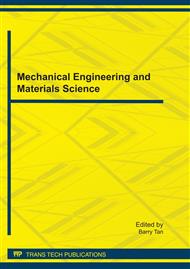p.3
p.7
p.12
p.18
p.24
p.30
p.35
p.41
Research on Cooling Effect with Cooling Groove Structure Parameters of Liquid Rocket Engine Thrust Chamber
Abstract:
To study the effects of wall thickness, rib height and groove width on cooling effect and pressure drop, three dimensional heat transfer of liquid propellant rocket engine with cooling groove is numerically investigated using gas-solid-liquid coupled heat transfer model. The one-dimensional model is adopted to describe the coolant flow and 3D heat transfer model is used to calculate the coupling heat transfer through the wall. In this text, wall thickness, rib height and groove width varied while the groove number is fixed and coolant mass flow rate remains constant. When liner material is QZr0.2 alloy, we find the optimal design point of the aspect ratio. Moreover, a fitting function of the optimal aspect ratio is acquired. The biggest error of the fitting function is 3.3% compared with numerical results.
Info:
Periodical:
Pages:
7-11
Citation:
Online since:
October 2011
Authors:
Price:
Сopyright:
© 2012 Trans Tech Publications Ltd. All Rights Reserved
Share:
Citation:


